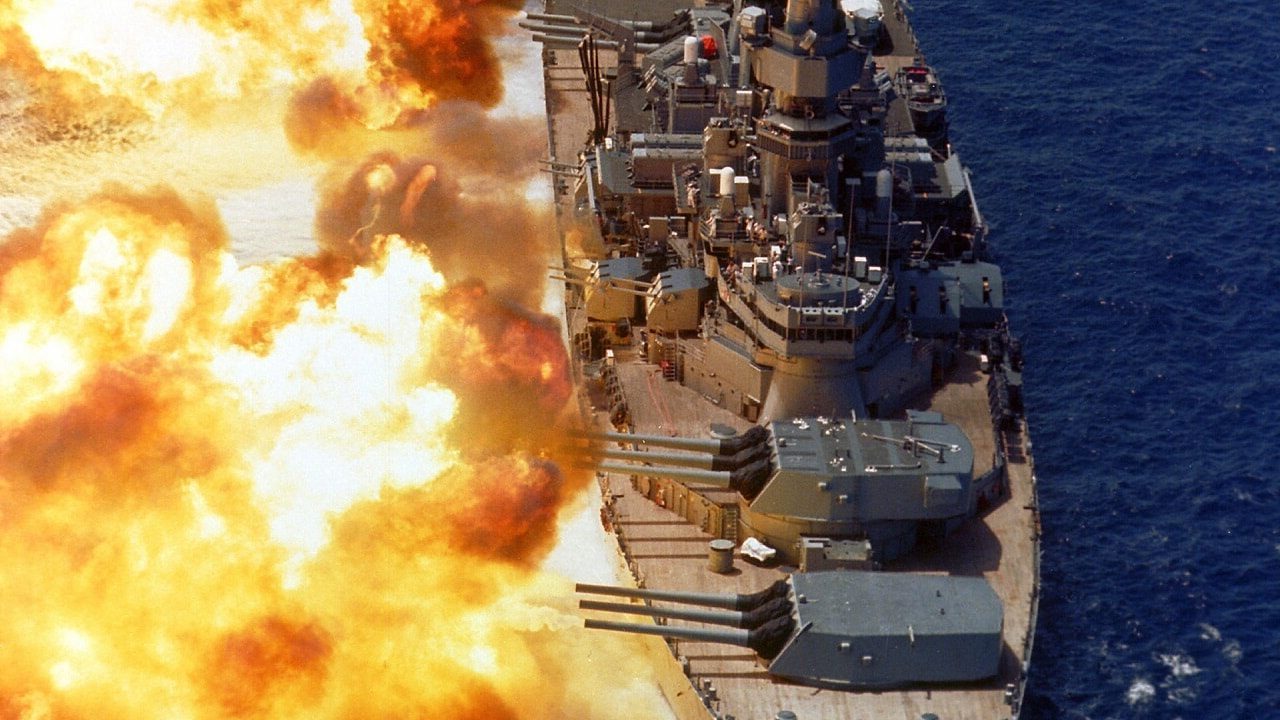Iowa-Class Battleships – You see a lot of articles over the years about them making a comeback. This is impossible. Here’s why:
The Iowa-class battleships were monsters on the high seas when brought back in the 1980s. Nuclear-armed Tomahawk missiles capable of attacking at ranges up to 1,700 miles, land attack Tomahawks able to travel 850 miles, and even ship-to-ship maritime Tomahawks all armed famous US Navy WWII-era Iowa class battleships. And, of course, don’t forget about those big 16-inch guns.
The sheer firepower of the Iowa class, which also included armor-piercing shells, dual-purpose 5-inch guns for surface bombardment up to 10 miles offshore, and harpoon anti-ship missiles, is likely the main reason why the US Navy brought the ships back to life during the Cold War in the 1980s. Two Iowa-class battleships attacked Iraq with missiles and 16-inch guns during the Gulf War in 1991.
The Iowa-Class Reboot: Explained
A fascinating issue of Popular Mechanics from June of 1982 details this firepower and explains the rationale for their return, a US Navy development that lasted into the early 90s.
Interestingly, the 1982 magazine article addressed critics of the ships at the time, expressing concern that the large battleships were vulnerable, easy targets, concerns which would likely prove even more relevant today.
In response, the Navy did something quite similar to what is employed today in Carrier Strike Groups, meaning warships such as cruisers and destroyers would surround and “protect” the larger battleship at the center of what the Navy called a Surface Action Group in the 1980s.
A Comeback in 2023?
But what would a comeback look like today? Concerns over survivability and being targeted would seem even more pressing and relevant today, given the advent of enemy longer-range precision weaponry such as anti-ship missiles.
However, the thinking at the time may have been somewhat analogous to what it is today concerning large, potentially vulnerable aircraft carriers. They are defended by warships and also increasingly being upgraded with new “layered” ship defenses to enable survivable operations in high-threat areas better.
At the same time, enemy threats are a big reason for the Navy’s Distributed Maritime Operations strategy which seeks to enable a more networked, disaggregated fleet supported by unmanned systems and long-range sensors.
But to address the question head on: is a comeback today possible? Iowa-class battleships would seem vulnerable, to be sure, as they are large targets, and enemy weapons are much longer-range and much more precise today as opposed to the 1980s.
However, ship defenses continue to evolve rapidly, introducing new EW-centered “jamming” technologies to disrupt RF guidance systems of anti-ship missiles and other defenses such as lasers and upgraded interceptor missiles. The Iowa-class did not have Vertical Launch Systems to fire interceptors such as upgraded SM-2s, SM-6s, or even SM-3s for longer-range threats. Perhaps they could be added?
What History Tells Us
There are clearly ship-defense parallels between the Cold War era Iowa-class ships and today’s warships in certain key respects, such as integrating the Navy’s long-standing Close-In-Weapons Systems.
CIWS, as they are called, have been protecting ships for decades with an ability to fire defensive projectiles to blanket an area with protection or intercept or stop incoming enemy drones, helicopters, and other air threats such as enemy ballistic missiles.
CIWS is built to protect ships from the closest-in threats by using a Phalanx “area” weapon to fire hundreds of projectiles into the air per second. Sure enough, CIWS armed Iowa class battleships, and in more recent years, the Navy has upgraded the protective envelope of CIWS to incorporate surface and air threats. This means CIWS can not only protect against incoming aerial projectiles, drones, and close-in-flying aircraft but also stop small boat attacks or enemy fire approaching close to the ocean’s surface.
There are other factors to consider, however, particularly when it comes to questions about “range” of Iowa-class weapons systems. While the images of those mighty 16-inch guns are impressive, there are clearly much better and more sophisticated weapons that can fire from much further distances and out of the range of enemy shore-based weapons. Sure, as noted above, the Iowa-class can be given modern weapons platforms, but what would be the cost/benefit analysis of such a decision?
Ultimately, the question is quite simple: Should Iowa-class battleships be upgraded with an entire range of modern ship-defenses, weapons and precision firepower, would they bring something of irreplaceable operational value to today’s Navy?
Perhaps the range of guns would need to be much farther and capable of precision strikes, lasers, EW, and even VLS may need to be added for protection, and the ship would need cutting-edge command and control, computing, and radar technology such as the Aegis Combat System. That all likely means the Iowa-class most likely will never sail again.
Kris Osborn is the Military Affairs Editor of 19FortyFive and President of Warrior Maven – Center for Military Modernization. Osborn previously served at the Pentagon as a Highly Qualified Expert with the Office of the Assistant Secretary of the Army—Acquisition, Logistics & Technology. Osborn has also worked as an anchor and on-air military specialist at national TV networks. He has appeared as a guest military expert on Fox News, MSNBC, The Military Channel, and The History Channel. He also has a Masters Degree in Comparative Literature from Columbia University.

